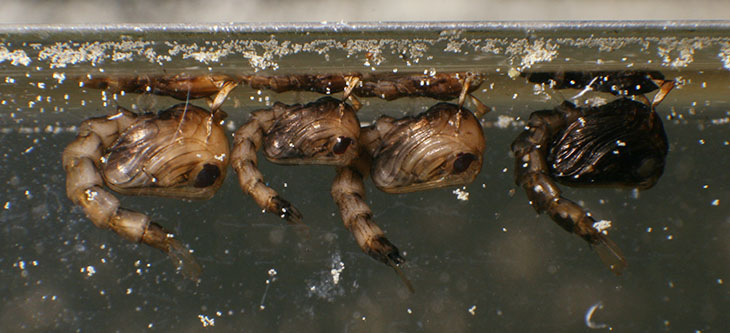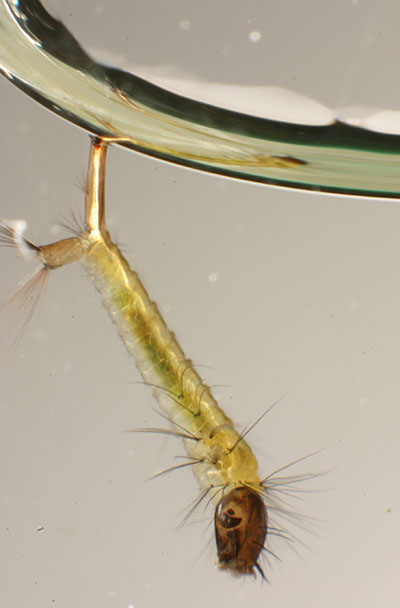 A couple of years ago, I captured a particular sequence of images that didn’t quite cut it, as far as I was concerned, and I’ve been trying to get a better set ever since. This evening, I was successful.
A couple of years ago, I captured a particular sequence of images that didn’t quite cut it, as far as I was concerned, and I’ve been trying to get a better set ever since. This evening, I was successful.
What you see to the left is a mosquito in larval stage. Mosquitoes lay their eggs in the water, usually a still pool for a particular reason we will eventually get to. They hatch out underwater and spend a significant portion of their lives there, most of it looking about like this. They remain air breathers, most species using a snorkel-like appendage located on their hind ends, so that’s the head facing downwards. They move by thrashing their bodies, propelled by the hairs on either end, and scarf their food from debris found on the bottom of the pool. They will molt four times in this stage, each period between molts referred to as an instar – seen here is likely the fourth instar, having gone three molts since merging from the egg. Then comes the pupal stage.
[Okay, I hear your questions, so let’s address them before we move on. No, this is not some weird kind of lens distortion or camera angle – the water surface really is that curved. Photographed in the ‘Tiny Tank‘ that I made, the water formed a serious meniscus due to the narrow space between the slides – it’s just a trick of surface tension.]
The pupal stage is a non-feeding stage, like it is in most arthropods – it’s when the mosquito’s voice cracks and they begin noticing the opposite sex in a whole new way. They don’t spend it locked in a cocoon like butterflies and moths, however; they still swim about, and have to go to the surface for air frequently, only now, they use snorkels at their shoulders instead of at the end of the abdomen. Don’t look at me, I didn’t design this.
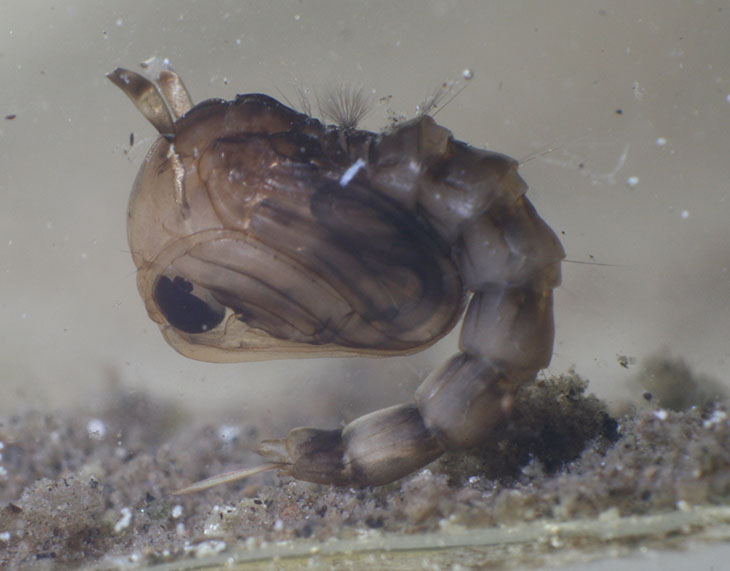
I had initially thought this was a different insect, and I doubt anyone can really blame me (not for that, anyway.) Within that big bulge are the developing wings, legs, antennae, and proboscis, with the eyes making those dark spots of course. In this stage, the mosquito will come to the surface frequently, often remaining there if nothing threatening is happening, but the slightest sign of danger will send them flipping downwards into the safety of deeper water. This is relative, of course, because that may be only a few centimeters. They remain in this crouched position all of the time, which is what clued me in that something was going to happen when I spotted this next display.
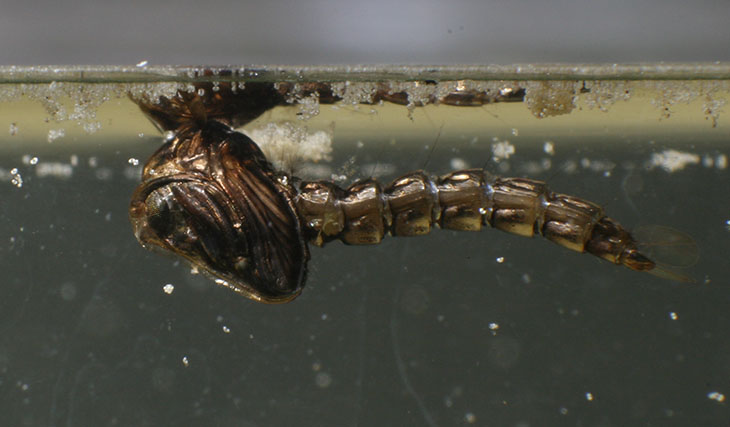
Seeing one stretched out straight like this was suspicious, and the burnished look just added to it – I’m guessing this is actually a layer of air as the mosquito is loosening its skin. Having captured a few pupae and placed them in the mid-sized tank, I raised the water level to the top of the glass, just before overflowing, so the distinct line you see across the image is not just the water level, but the glass edge as well. All of the junk you see herein is pollen, which is freaking everywhere right now and impossible to keep out of the water.
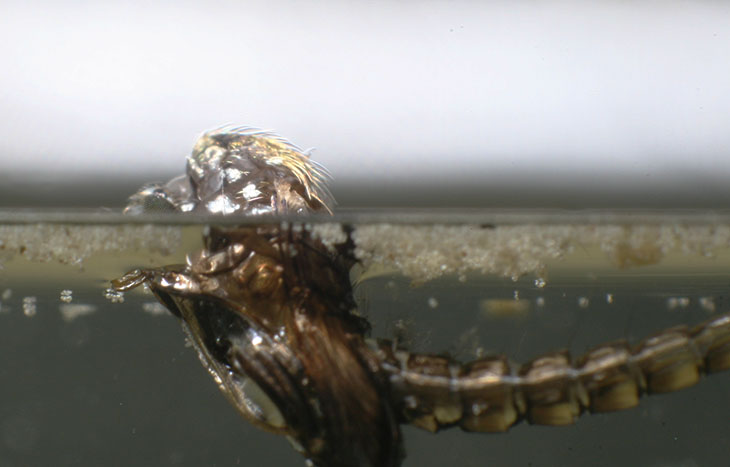
I didn’t have long to wait. With a couple of preliminary twitches like an escape artist loosening up the straitjacket, the adult mosquito began to emerge from both its old skin and the water itself. The magnifying effect of the water makes this slightly disconcerting, but still shows what’s happening both above and below.
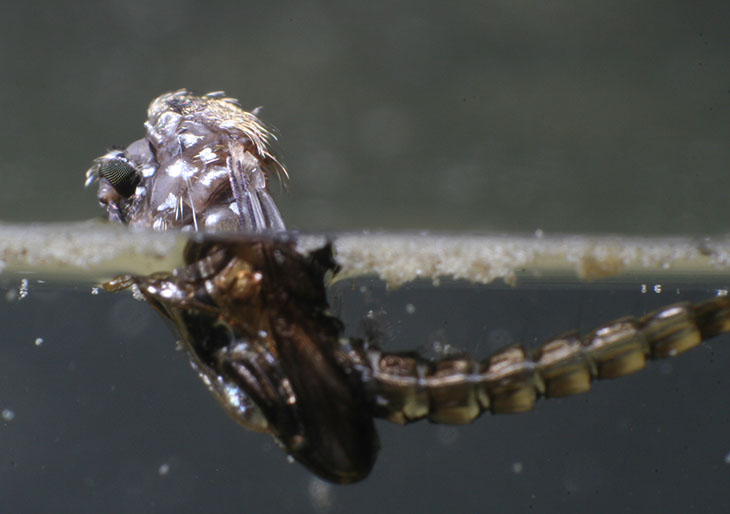
This isn’t quick, but it isn’t as slow as some insect activity that I’ve seen either. There’s no visible motion, but every time you look you realize the adult is a little further out.
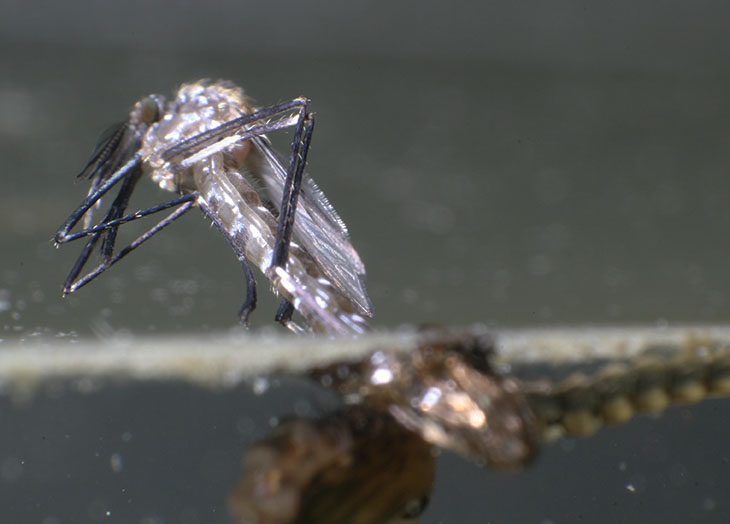
In three minutes, the adult has gotten far enough out to release the legs, which flex upwards and ‘ease the kinks out’ before extending down to the water’s surface. If you look beneath the surface, you can see the out-of-focus blob of another pupa who came up for air right alongside and remained there, photobombing part of my sequence.

Now the emerging mosquito has extended its legs down to the water, but things are still moving slowly at this point – most likely, the chitin is drying and hardening while fluid is being pumped into the legs, wings, and antennae. This is the vulnerable stage, and the reason why mosquitoes lay their eggs in still water like stagnant ponds, deep puddles, and any basin that might be left collecting water. Any ripple or splash at this point can waterlog the insect, since it has not yet developed the water-repellent properties of the adult stage, meaning the mosquito can drown easily. Many do; it’s not uncommon to find several drowned adults in any active pond, having been caught by a gust of wind or a splash when they’re most vulnerable.

The wings are almost useless at this point, unable to support the mosquito’s weight, but this won’t last more than a couple of minutes. The emerged adult tugs its abdomen free of the molted skin, leaving it sitting just under the surface while standing on the water and getting psyched at finally being legal age.
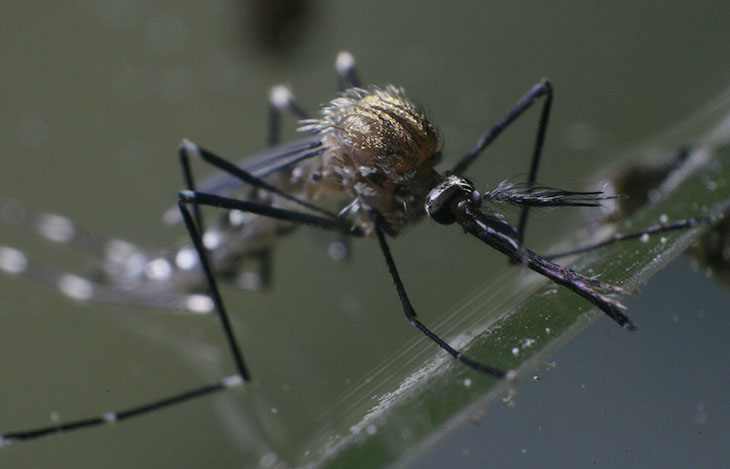
Within a few minutes, the adult will be ready to fly, so I’m going to horrify some and gratify others to say this is the point where I swatted my model. Both The Girlfriend and The Younger Sprog are allergic to mosquitoes, and even a minor bite will produce a wicked welt; neither of them is wild about my letting the little suckers hatch out just for these images. It doesn’t help that, for some reason, I’m next to immune to mosquitoes, not attracting them much at all and barely noticing their bites when I do, while the ladies will get eaten alive on any humid summer eve.
I’m going to close with one last image, as a collection of pupae all lined up together against the glass. Their reflections from the underside of the water surface can be seen, as well as lots of pollen. I can’t tell you why the one is so dark – my guess is that it’s the early stage pupa and will become as light as the others in a day or so. But hey, when they line up so cooperatively (especially when they’ll dive away if I move incautiously,) I have to take the shot.
